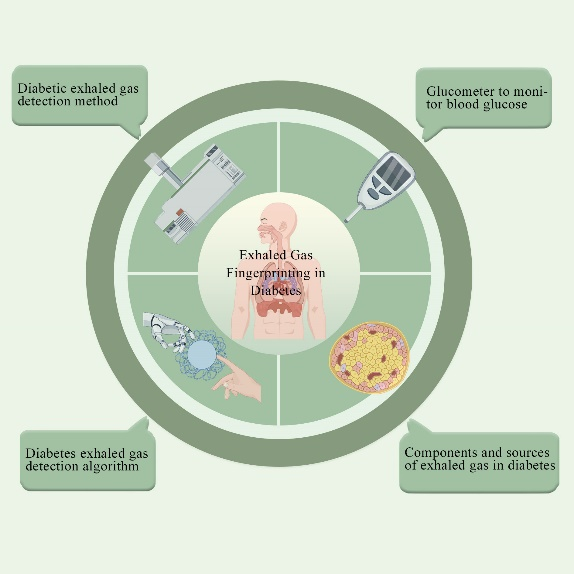1 引言
2 糖尿病呼出气体的成分和来源
2.1 呼出气体组成
2.2 糖尿病患者呼出气体成分的变化原因及其生理来源
表1 糖尿病呼出气体潜在生物标志物[20,25,26,29,32,36]Table 1 Exhaled breath potential biomarkers of diabetes[20,25,26,29,32,36] |
| Marker name | Source/Association with diabetes |
|---|---|
| Acetone | Excessive breakdown of fat and increased concentration of ketone bodies in the blood. |
| Isopropyl alcohol | Acetone reduction produces. |
| Potassium nitrate | The appearance of hyperoxidation in the body and an increase in the concentration of ketone bodies in the blood. |
| Isoprene | Lipid peroxidation process related. |
| 8-isoprostane | It is the end product of unsaturated fatty acid lipid peroxidation (non-enzymatic reaction) catalyzed by free radicals, and its production is closely related to oxidative stress damage in the body. |
3 糖尿病呼出气体检测方法
3.1 气相色谱检测方法
3.1.1 呼出气体样品采集
3.1.2 呼出气体样品预富集
3.1.3 GC、GC-MS方法
3.2 质谱直接检测方法
3.3 光谱学检测方法
3.4 传感器检测方法
表3 糖尿病呼出气体检测方法比较[41,43⇓~45,65,91,104]Table 3 Comparison of diabetic exhaled gas detection methods[41,43⇓~45,65,91,104] |
| Methods of analysis | Vantage | Drawbacks |
|---|---|---|
| GC/GC-MS | 1. Good ability to recognize compounds. 2. High sensitivity. 3. High accuracy. | 1. Requires sample preparation. 2. Requires pre-concentration. |
| SIFT-MS | 1. High sensitivity. 2. Low detection limit. 3. Fast Response. | 1. Unrecognizable compound. |
| PTR-MS | 1. High sensitivity. 2. No pre-concentration. 3. No sample collection required. 4. Strong resistance to environmental factors. | 1. Unrecognizable compound. 2. The detection range is narrow |
| Spectroscopic methods | 1. Real-time detection of low concentration compound molecules. 2. High resolution. 3. High selectivity. | 1. Poor ability to detect multiple compounds simultaneously. |
| E-nose | 1. Low cost. 2. Small size. 3. Easy to operate. | 1. Cannot screen for multiple diseases. 2. Due to the influence of water vapor in the analyte, a single compound in the complex gas mixture cannot be identified. |
4 糖尿病呼出气体检测算法
表4 糖尿病呼出气体检测算法[105,106,108⇓⇓ ~111]Table 4 Diabetes exhaled gas detection algorithm[105, 106, 108~111] |
| Algorithm | Vantage | Drawbacks |
|---|---|---|
| SVM | 1. High efficiency. 2. Strong generalization ability. 3. Suitable for complex data sets. | 1. Not applicable to multiple classification problems. 2. Sensitive to missing data. |
| CNN | 1. Automatic feature extraction. 2. Hierarchical feature learning. | 1. Risk of overfitting. |








